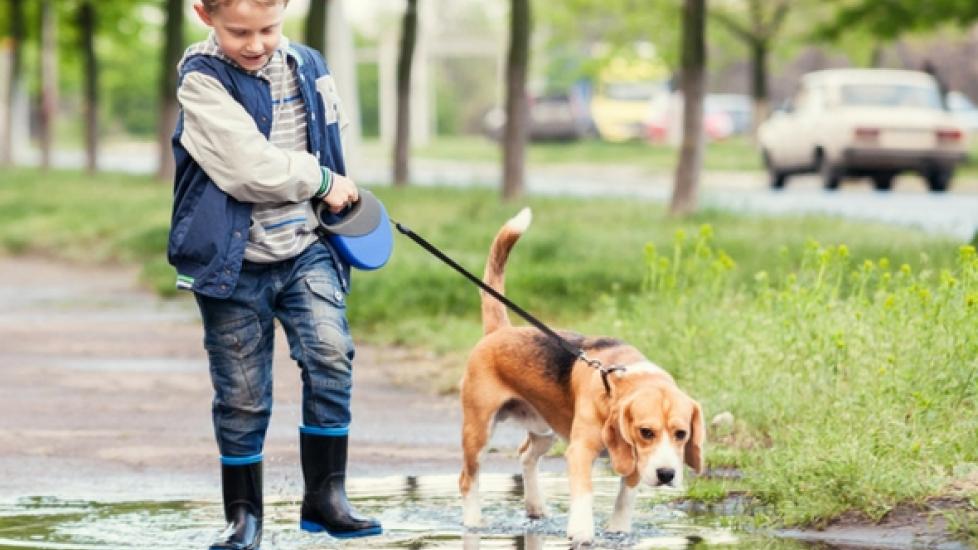Can Dogs Teach Kids Responsibility?
By Terry Kaye
Dogs help us to stay fit, keep us company, and offer unconditional love and companionship. Families with kids have yet another reason to own a dog: According to the American Pet Product Association’s 2011-2012 National Pet Owners Survey, 58 percent of pet owners say their pets help teach their kids to be responsible.
But what do the experts say? Can dogs really teach kids responsibility? Overwhelmingly, the answer is yes, as long as it’s done the right way.
Create Age Appropriate Tasks
Older kids and teens are able to do more than younger kids, but even the youngsters can help out.
Little Kids Can…
- Help you dry the dog’s supper dish after you wash it.
- Alert you when the dog’s water bowl needs to be refilled.
- Help you brush the dog. Hold the brush together, or get a “child-size” brush and show them how to brush gently.
Older Kids Can…
- Help feed the dog. Ask your child to fill the bowl with a pre-measured amount of food. Do not allow the child to set the bowl down unless you are sure the dog has no food-aggression issues.
- Help put the dog’s toys away at the end of the day.
- Exercise the dog. Playing fetch, running, or rolling around will give dogs and kids exercise, and strengthen the bond between them.
- Train the dog. Try taking a dog training class with your child, or look for a dog training class for kids.
- Walk the dog. Make sure they know how to hook the leash onto the collar securely, and that the dog listens to their commands. And, of course, make sure they have enough poop bags and that they always use them.
Educate and Encourage
Teach Them to Think Like a Dog: Kids need to know more than just the what and the how, they also need to know the why. Explain to your child that a dog is a living, breathing creature, just like them, and that
it has the same kinds of physical and emotional needs. “Help your child identify with the pet and the importance of getting those needs met,” says Candi Wingate, president of Care4Hire.
Be a Role Model: Even the most responsible child makes mistakes, and it is ultimately the adult’s job to make sure that the dog gets proper care. These moments can be educational, too. Ask the child why they did not feed or walk the dog, and then ask them to think about how that might have affected the dog. Come up with a plan together for how to do better next time. “We as parents must be willing to teach, and often the way children learn is by example,” says Cheryl Orletsky, dog trainer and founder of Holiday Pet Care. “The parents must be willing to show the child what proper care of a dog entails, and then lovingly remind them over and over again, partly in words, but often accompanied by stepping in to ensure proper care is maintained.”
Make it a Privilege, Not a Chore
A child may feel picked on if they are given jobs they do not want or understand. A reluctant child may respond well to sharing jobs with a parent. When they help you, give enthusiastic feedback. Let the child know how much you and the dog appreciate their help. Leave time after chores for play or training with the dog.
Another idea is to allow the child to choose which caregiving tasks they will be responsible for: feeding, walking, grooming, or exercising the dog. Allowing the child to choose gives them true “ownership” of that task, and will encourage them to follow through.
Show the child how their actions help the dog by keeping it healthy, keeping its coat smooth and shiny, or learning a new trick. Celebrate their accomplishments and help them understand that there are consequences if they don’t do what they agreed to do. Never make caring for the pet a punishment; it should be a rewarding experience for both child and dog.
Dogs and Kids: Teaching Responsibility, for Life
Kids who take care of dogs learn what it feels like to have a living creature rely on them, and that teaches responsibility in a way little else can. Caring for a dog creates a sense of empathy and a respect for life. It teaches commitment and consistency, and it builds self-confidence. Your encouragement, along with the tail-wagging gratitude of the dog, will create a lasting feeling of self-esteem that will follow the child through life.
